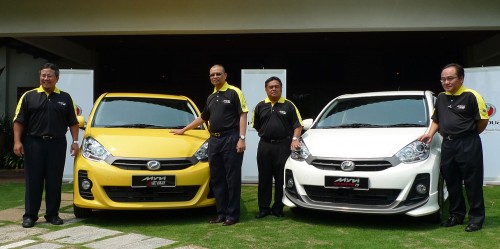
After rounds and rounds of spyshots, this time, it’s the real thing. Moments ago, Perodua officially launched the much anticipated Myvi SE 1.5 which is a new Myvi with a 1.5-litre engine, the biggest capacity lump that has ever been put into the popular hatchback.
And if the new Myvi launched in June is called “Lagi Best” (34,000 people agree and have booked the car) the Myvi SE’s tagline is “Lagi Power, Lagi Best”, referring to the bigger 1.5L engine powering the car.
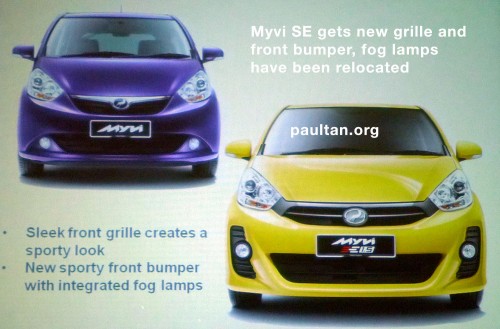
There’s also the Myvi Extreme 1.5, a name which we broke last week. The Extreme is essentially the same car as the SE, but with a more extreme bodykit and some added kit. It can be immediately recognised by the grey lower lip missing on the SE.
At the back, the Extreme gets a unique bumper, a more elaborate spoiler and chrome door handles. The new seven-spoke rim design and grille insert are shared by both.
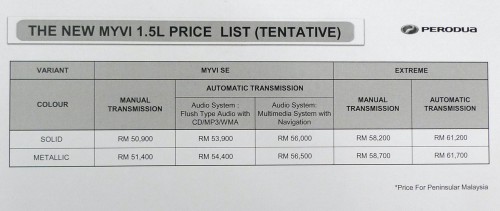
Both the SE and Extreme are available with a four-speed auto gearbox or a five-speed manual. Prices range from RM50,900 for the SE manual to RM61,700 for the Extreme auto, figures that are lower than some have speculated. To recap, the Myvi 1.3 range starts from RM43,900 and tops out at RM57,400 for the 1.3 Elegance auto.

Myvi Extreme (white) easily identified via grey bumper lip, fog lamp housing has less bars
Let’s start with the heart of the matter. The SE and Extreme are powered by a 1.5-litre twin-cam engine with DVVT. This is the 3SZ-VE engine used in the Alza, and not the 1NZ-FE from the Toyota Vios. The chain driven (timing chain, not belt) engine puts out 102 hp at 6,000 rpm and 136 Nm of torque from 4,400 rpm, a 12 hp/19 Nm jump from the Myvi 1.3.
While this is lower than the Vios’ 108 hp/141 Nm, the Myvi 1.5 (at 970 to 995 kg) is lighter than that sedan, and Perodua’s power-to-weight ratio charts sees the SE beat the “Model SS” (Suzuki Swift), “Model V” (Vios) and “Model P” (Persona).
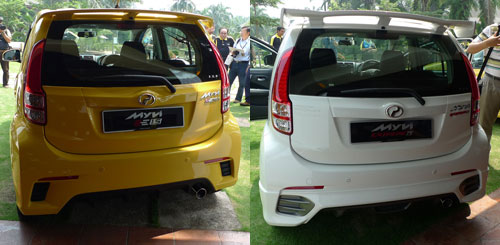
Rear bumper design is unique for each variant, Extreme gets a more elaborate spoiler
Lagi power eh? The Myvi 1.5′s acceleration is not to be scoffed at – the SE manual does the 0-100 km/h sprint in just 9.98 seconds, which is very swift. To compare, a BMW 320i Sport does the same sprint in 9.8 secs, so don’t play play! The Myvi SE auto is timed at 12.49 seconds. So 2.0L sedan owners, don’t be too surprised if that pesky yellow thing runs neck-to-neck with you in the traffic light GP!
As for fuel consumption, Perodua claims 15.9 km/l for the manual and 12.9 km/l for the auto. These figures are slightly down from the 1.3L, but are still better than competing national cars, says P2.
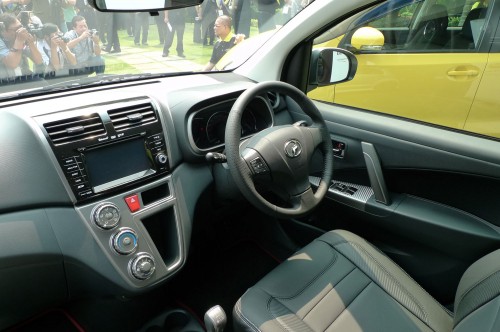
All black interior and steering buttons are standard, Extreme gets leather seats and tinting
Inside, the Myvi 1.5 gets an all black dashboard and interior, unlike the dual-tone scheme on the standard car. The steering wheel is now wrapped in leather, and there are audio controls on the left spoke, a first in Myvi history. The front seats are also unique – Perodua calls them “semi bucket seats”.
Start the car and you’ll also realise that the Camry style instruments – orange illumination in 1.3 Standard, turquoise in the Premium/Elegance – is now in red, with white for the needles and trip computer. The dial design is also slightly different and there are chrome rings thrown in. The plastic surround for the meter panel is now in sliver.
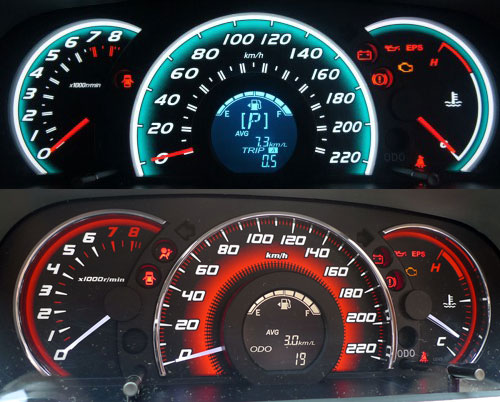
Myvi 1.5 instruments are in red and white, design is different, chrome ring added
 The Myvi SE comes with the “flush type” audio system as seen in the Myvi 1.3 Premium. This one has Bluetooth, USB and the a sliver carbon fibre look, but the backlight is now red to match the instruments.
The Myvi SE comes with the “flush type” audio system as seen in the Myvi 1.3 Premium. This one has Bluetooth, USB and the a sliver carbon fibre look, but the backlight is now red to match the instruments.The full colour DVD touch screen system with navigation found in the Myvi 1.3 Elegance is an option for the SE automatic and standard on the Myvi Extreme.
The other additional kit that are exclusive to the Myvi Extreme include leather seat covers (with Extreme badge on the front seat backs), Extreme carpet mats (driver’s mat comes with locks to keep it in place), and window tint. These are in addition to the exterior differences mentioned and shown above.
Article sources: paultan.org


